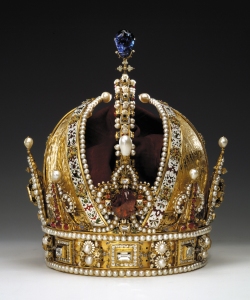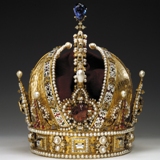Imperial Crown of Austria
 This crown was originally manufactured for Emperor Rudolf II in 1602 and was from 1804 onwards used as the Crown of the Austrian Empire (also known as the Crown of Rudolf II, Rudolphian Crown). The reason for commissioning an own private crown made was, that the Imperial Crown together with the other Imperial Regalia could only be used for coronation ceremonies, but not for everyday use of kings or emperors. If a ruler wanted to wear a crown not only for coronations but also for other events, he had to have an own personal crown to be made.
This crown was originally manufactured for Emperor Rudolf II in 1602 and was from 1804 onwards used as the Crown of the Austrian Empire (also known as the Crown of Rudolf II, Rudolphian Crown). The reason for commissioning an own private crown made was, that the Imperial Crown together with the other Imperial Regalia could only be used for coronation ceremonies, but not for everyday use of kings or emperors. If a ruler wanted to wear a crown not only for coronations but also for other events, he had to have an own personal crown to be made.
Rudolf II was not the only emperor with a private crown, but most of the other private crowns were broken after the death of their owner and its parts were reused in other artefacts. When Emperor Rudolf II died in 1612, his private crown was not destroyed because of its outstanding beauty and artistic value. On the contrary, it became the Crown of the Habsburg family. Thus it was used during the coronation of Josef II to King of the Romans and was worn by Emperor Francis Stephen of Lorraine, who attended his son's coronation.
When due to Napoleon's pressure the disintegration of the Holy Roman Empire became inevitable, Emperor Francis II proclaimed the new Austrian Empire on 11 August 1804, which he from then onwards ruled as Emperor Francis I. At that time, almost two centuries after its manufacture the unofficial private crown then became the official imperial crown and was used until the collapse of the Austrian Empire after the First World War. The Imperial Crown of the Habsburg Empire was never used for a coronation, as it was a hereditary monarchy and therefore no need for a coronation ceremony to obtain the imperial title.
The artistic programme of the Crown of Rudolf II
The Crown of Rudolf II consists of basically three principal elements: a circlet with its fleur-de-lis mounts symbolizing a royal crown, a high arch obviously inspired by the Imperial Crown of the Holy Roman Empire and a mitre, which reminds of the traditional liturgical headwear of bishops from many Christian churches. Each of these three main elements contains a clear statement: The circlet symbolizes that Rudolf was both, King of Bohemia and Hungary. The High Arch reminds us of the Roman imperators on the one side and of the Imperial Crown of the Holy Roman Empire on the other side. The mitre for its part symbolizes the divine right of archpriest and his right to rule as representative of God on Earth.
The Crown of Rudolf II owes its magnificent splendor to the reliefs of Mitre's four spherical triangles, which show the coronation in Regensburg, Pressburg (Bratislava) and Prague (Praha) as well as his victory over the Ottomans, depicting Rudolf's four principal offices: Imperator as victor over the Ottomans, Emperor, King and once more King. The Crown is also famous as one of the masterpieces of Jan Vermeyen from Antwerp, one of the most outstanding goldsmiths of his time, who made this remarkably beautiful enamel works as well as the rich decoration with pearls and jewels, which integrate into a complex iconographic programme.
If you want to know more about the Crown of Rudolf II and the significance of the types and number of its jewels, you will get more detailed information inter alia during our fascinating and informative guided tours of the Vienna treasury museum.
